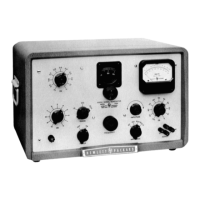trol panel).
Unless the noise level in the output signal is
non-critical, the output amplifier always should be adjusted
for
a
meter indication of t15 dbm.
b.
Determine the level in dbrn for the output voltage desired.
The quick-reference graphs referred to above are arranged
to show the relationship between db referred to 1 milliwatt
into a matched load and the voltage across a corresponding
matched load. To determine the level in dbrn for an output
voltage of
.
23 volts into 600 ohms, for example, refer to
the graph and find the level in dbrn for .23
volts into 600
ohms. The level will be found to be -10.5 dbm.
c.
Compute the amount of attenuation required to bring the out-
put
down to the desired level. With the output from the am-
plifier at
t15 dbm, attenuation of 25. 5 db will be required
to bring the output to
-
10. 5 dbrn at the OUTPUT binding
posts
(t15 dbrn minus 25. 5 db equals -10. 5 dbrn).
d.
Set the attenuator for the loss
requi~ed. The loss inserted
by the attenuator is the sum of the settings of the dials.
Using as an example the condition described above where
a loss of 25. 5 db is required,
all
three dials will be set
for loss (20 db
t
5 db
t
.
5 db equals 25. 5 db).
NOTE
A method for determing the voltage across a
non-matching load is described below in para-
graph 5. Setting Output Impedance.
5. Setting Output Impedance
The output impedance of the generator is determined by the set-
ting of the IMPEDANCE switch. For balanced 50-, 150-, or
600-ohm operation, set the IMPEDANCE switch to 50, 150, or
600. For balanced-to-ground operation, patch binding post CT
to binding post G.
For 50- or 150-ohm unbalanced operation, set the IMPEDANCE
switch to the 50 or 150 position,
and connect the lower OUTPUT
binding post to ground at terminal
G.
For 600-ohm unbalanced operation,
set the IMPEDANCE switch
to
600G. At the 600G position, the IMPEDANCE switch connects
the lower OUTPUT binding post to the
G
binding post. (In the
600G position, the matching transformer is bypassed, and an
advantage in distortion and frequency-response characteristics
is obtained.
)

